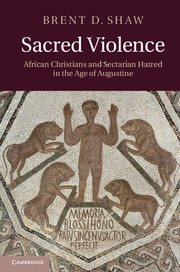Book contents
- Frontmatter
- Contents
- Abbreviations
- Maps
- Acknowledgments
- Introduction
- Chapter 1 This terrible custom
- Chapter 2 Church of the traitors
- Chapter 3 A poisonous brood of vipers
- Chapter 4 Archives of memory
- Chapter 5 The city of denial
- Chapter 6 Ravens feeding on death
- Chapter 7 Little foxes, evil women
- Chapter 8 Guardians of the people
- Chapter 9 In the house of discipline
- Chapter 10 Sing a new song
- Chapter 11 Kings of this world
- Chapter 12 We choose to stand
- Chapter 13 Athletes of death
- Chapter 14 Bad boys
- Chapter 15 Men of blood
- Chapter 16 Divine winds
- Chapter 17 So what?
- Appendix A Bishops and bishoprics in Africa: the numbers
- Appendix B Origins of the division: chronology
- Appendix C The Catholic conference of 348
- Appendix D The Edict of Unity and the Persecution of 347
- Appendix E The mission of Paul and Macarius
- Appendix F Historical fictions: interpreting the circumcellions
- Appendix G The archaeology of suicide
- Appendix H African sermons
- Bibliography
- Index
- References
Chapter 14 - Bad boys
Published online by Cambridge University Press: 07 September 2011
- Frontmatter
- Contents
- Abbreviations
- Maps
- Acknowledgments
- Introduction
- Chapter 1 This terrible custom
- Chapter 2 Church of the traitors
- Chapter 3 A poisonous brood of vipers
- Chapter 4 Archives of memory
- Chapter 5 The city of denial
- Chapter 6 Ravens feeding on death
- Chapter 7 Little foxes, evil women
- Chapter 8 Guardians of the people
- Chapter 9 In the house of discipline
- Chapter 10 Sing a new song
- Chapter 11 Kings of this world
- Chapter 12 We choose to stand
- Chapter 13 Athletes of death
- Chapter 14 Bad boys
- Chapter 15 Men of blood
- Chapter 16 Divine winds
- Chapter 17 So what?
- Appendix A Bishops and bishoprics in Africa: the numbers
- Appendix B Origins of the division: chronology
- Appendix C The Catholic conference of 348
- Appendix D The Edict of Unity and the Persecution of 347
- Appendix E The mission of Paul and Macarius
- Appendix F Historical fictions: interpreting the circumcellions
- Appendix G The archaeology of suicide
- Appendix H African sermons
- Bibliography
- Index
- References
Summary
As far as Catholics were concerned, the most feared agents in the sectarian violence of the time were wandering bands of men and women whom they called “circumcellions.” The involvement of circumcellion gangs in the religious violence of the age is a well-documented phenomenon. These armed enforcers damaged and destroyed property and physically harmed the persons of their hated sectarian enemies, sometimes even killing them. The circumcellions were emblematic of violence not only for their contemporaries, but also for historians of our own day. The modern literature on them has accumulated into a mountain of scholarly invention. The circumcellions have been variously seen by historians as peasant revolutionaries, as the spearhead of a late antique jacquerie that swept the countryside of Africa, or as wandering ascetic monks of violent disposition who worshiped at the shrines of their models, the martyrs of the dissident cause. More generally, they are seen as simple religious fanatics who were devoted to violent, sometimes suicidal, attacks on their enemies or, worse, who engaged in mad mass suicidal self-killings of themselves. Whatever the construal of their motives or origins, circumcellions are usually portrayed as wandering groups of hardened men closely attached to the dissident church who vented their sectarian hatreds in violent attacks on Catholics.
Despite these confident modern pictures (some of them elaborate and detailed) and as central as the circumcellions are to the reconstruction of the sectarian violence of the time, there are severe limits on what can be known about them. Were it not for literary sources, mainly Augustine's rhetorical attacks on them, and a single lone reference in our legal sources, the cold fact is that little or nothing would be known about them. If we depended on these other sources, they would not be in our histories of the time. They have left no discernible trace in any material remains – that is, in the archaeological record – or in the many kinds of written texts that have been preserved from the period that are strewn with references to the religious life of the age. In the rich mother lode of tens of thousands of Latin epigraphical texts from Africa, for example, the circumcellions simply do not exist. The plain fact is that from the very beginning these sectarian gangsters were an ideological construct which lived on in precise kinds of writings and nowhere else. The way that they exist in these specific texts, and in no others, makes sense, since name-calling was central to the quarrels of the time. To label any group of persons as “circumcellions” was most of the point of writing about them. An equally significant aspect of the problem is that the violent men never once referred to themselves as circumcellions or conceived of themselves as such.
- Type
- Chapter
- Information
- Sacred ViolenceAfrican Christians and Sectarian Hatred in the Age of Augustine, pp. 630 - 674Publisher: Cambridge University PressPrint publication year: 2011

